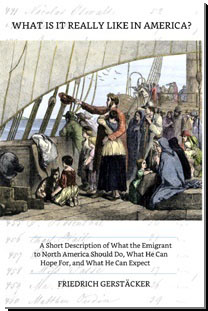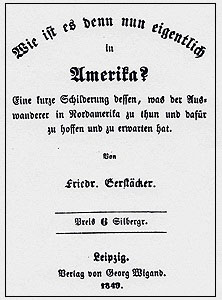|
What is it really like in America?
A Short Description of What the Emigrant
to North America Should Do, What He Can Hope For, and What He Can Expect
 |
|
Imagine
for a moment you are a poor farmer or laborer in central Europe
in the 19th century. You can barely feed yourself let alone a
family, and you’ve suffered through wars and revolutions. If you
are a young person, you see no hope of making a new life for
yourself. If you have a family, you see no opportunities for
your children or your children’s children to have a better life.
You’ve heard wondrous tales of a place called America—land
agents and ship companies have flooded Europe with advertisements describing how
easy it is to become wealthy and free in the new land. But
you’ve seen no pictures and met no one who has ever been there.
If you decide to leave the only home you’ve ever known, you will
likely be able to take only the belongings you can carry on your
back. You will leave behind forever not only the only town you
have ever lived in, but friends, family, and perhaps even some
of your children. You will move to a country you have never
seen, a country where you know no one, a country whose language
you do not even speak. But how to know what life in America is
really like? Who can answer your many questions? What is the
best time of year to leave for America? What is a sea voyage
like? What can I expect when I land in America? This was the
situation for many would-be emigrants in 19th century Europe. |
|
Friedrich Gerstäcker, a
German adventurer and prolific novelist, was born in Hamburg in 1816.
Throughout his life he seemed unable to stay put in one place for any
length of time. He began traveling in his early 20s and made his first
trip to North America in 1837. He spent 6 years moving about the United
States (spending time in Arkansas in particular), supporting himself
with odd jobs along the way, and writing home about his adventures in
the New World. He returned home in 1843 and using his experiences in
America, published his first novel in 1845. During this time he found
himself besieged by questions from people who wanted to know what life
was like in America, in particular from those people who wanted to
immigrate to the United States. Concerned that so many of the things
Europeans heard about America were inaccurate and idealistic, he decided
to write a practical guidebook for those who wanted to emigrate by
presenting a realistic picture of what they could expect in the New
World, answering questions ranging from the simply curious (What is
seasickness?) to the practical (How do I keep from being
swindled?). Gerstäcker published "Wie ist es denn nun eigentlich in Amerika?
Eine kurze Schilderung dessen, was der Auswanderer in Nordamerika zu
thun und dafür zu hoffen und zu erwarten hat" in 1849. |
|
 |
While Gerstäcker was not shy about describing the difficulties the new
emigrant would face in America, he was, at the same time optimistic,
ending his guidebook by writing that
“when it no longer suits you in the
old fatherland, fearlessly take the traveler’s staff in hand and seek a
new, secure home in the fertile valleys of that distant world. The
beginning is difficult, but in the end you will be amply rewarded for
the pain and trouble you have overcome, and you may look into the future
with peaceful and untroubled eyes. You will not see sorrow and misery
for yours and you, but rather a happy old age in the bosom of your
family, and if perhaps not great abundance and wealth, never-theless a
good and secure livelihood for your children.”
Gerstäcker would travel
again to America, and also to South America, the South Pacific, and even
Australia, and continue to write both travel observations and novels. He
died in Germany in 1872.
This small guidebook is now available in English and will be of interest
to anyone whose ancestors emigrated from Central Europe in the 19th
century.
This 19th century guidebook is now available as an
eBook and also an
audiobook.
|

